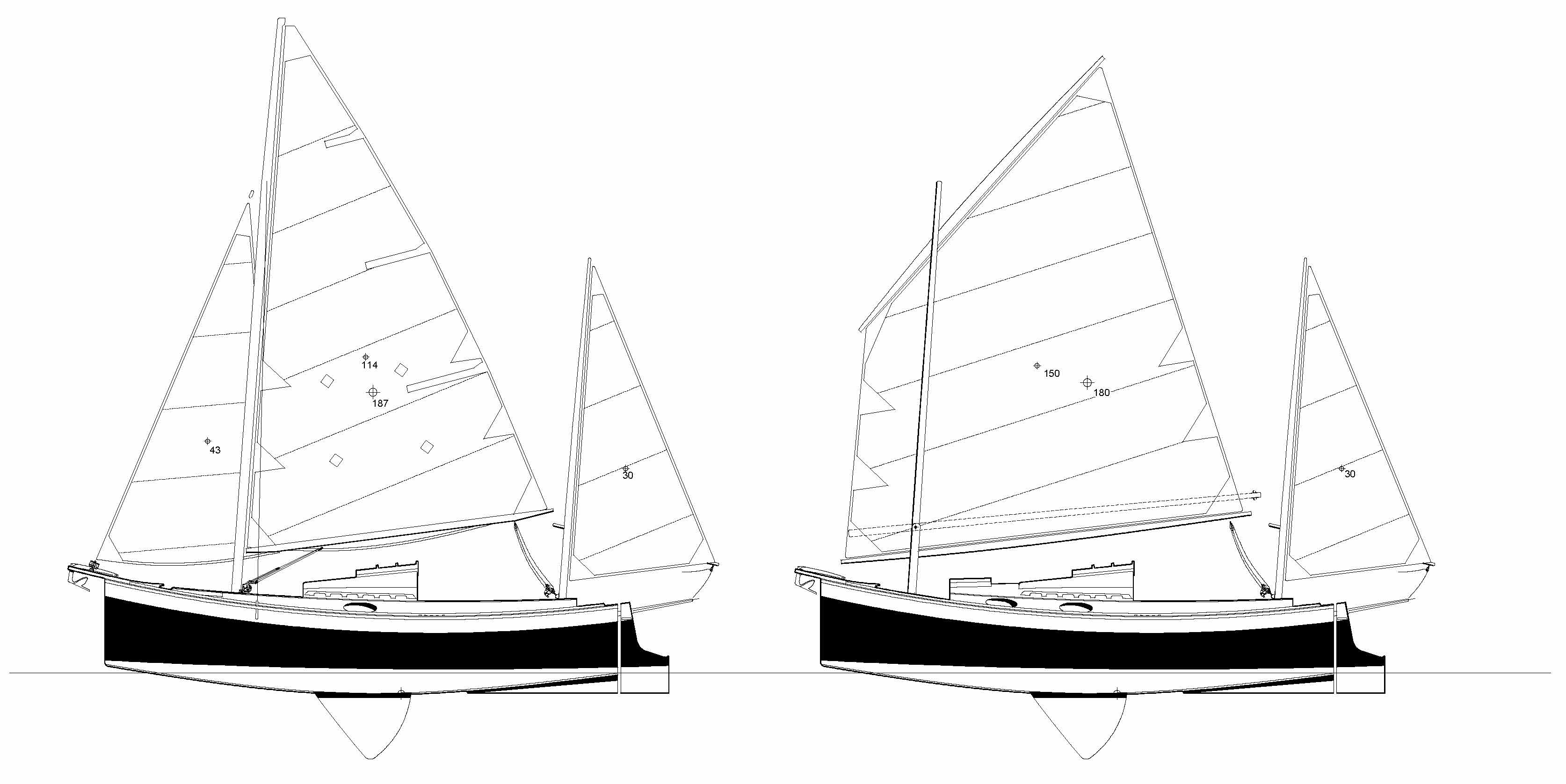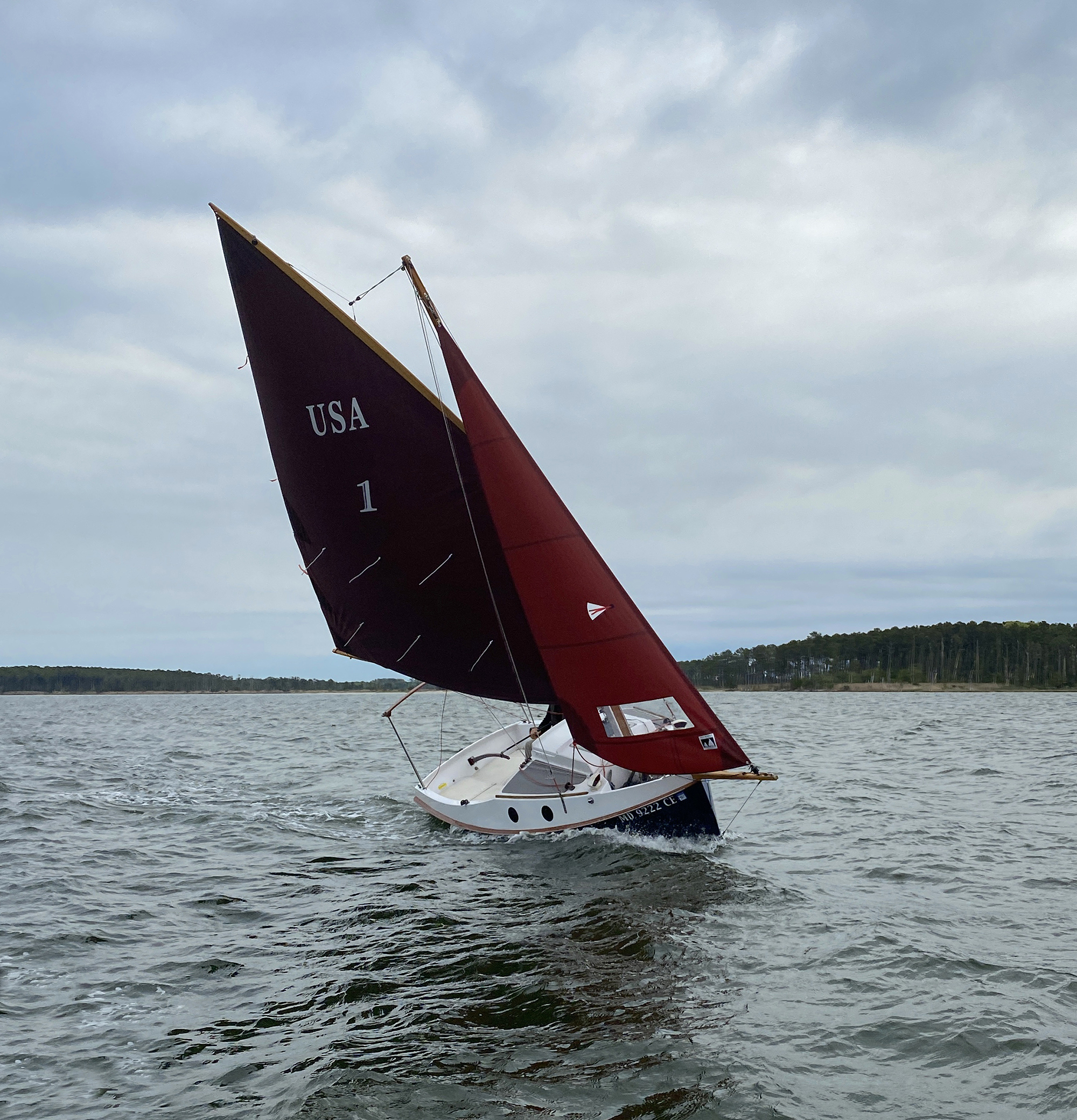Lugs and Jibs: An "Autumn Leaves" Update
By John C. Harris
May 2022
 |
| "Autumn Leaves" 18'5" x 5'0" 5.61m x 1.52m Draft 8" boards up, 37" boards down Displacement 1500lbs (681kg) |
You can download plans for Autumn Leaves here.
The Shallow Water Sailors are an informal collection of small boat nuts who for over 40 years have been gathering on the Chesapeake to cruise. I've had the privilege of joining their spring or fall retreats from time to time. A Shallow Water Sailors cruise is notable for its near-complete absence of fixed itinerary or programming. A locale and launch ramp are announced, always a pretty place with the right mix of open water and protected coves. The Wye, Chester, and Sassafras Rivers, for example. Skippers launch whenever they happen to arrive, and a fleet of small boats fan out. Some open, some decked-in, some modern, some neo-traditional. Some skippers sail in groups, some aren't seen for three days. Rafting up for dinner is optional. Everything is optional. The typical Shallow Water Sailor's cruise, in abandoning the regimented schedule of a regatta or formal cruising rally, embraces an experience reminiscent of a child's carefree summer day.
 |
|
Saturday night raft-up with the Shallow Water Sailors. Two Autumn Leaves yawls on the left; an Edey & Duff Dovekie on the right. The Dovekie was one of many inspirations for Autumn Leaves. |
This year's destination was the St. Mary's River, a quiet, tree-lined tributary of the Potomac River, an hour southeast of Washington, DC. I heaved a couple of tote bags of food and warm clothing into PocketShip and trundled down from Annapolis to join the fun. I was also carrying a couple of nice cameras for mercenary reasons: the first two examples of my Autumn Leaves design to hit the water had joined the cruise. Both were built closely to spec, and, even more interesting to me, one carried the lug-rigged option, and the other the jib-headed sailplan.
The black-hulled jib-header was built from plans by Al Stead at his home in Minnesota, and was in fact the very first Autumn Leaves to launch. Al's a skilled carpenter and I'd followed construction eagerly. Health challenges slowed the project; after a brief trial with an incomplete rig, Al had to hand the project off to Eric Vance, who lives in northern Virginia. Eric was close enough to Chesapeake Light Craft that we were able to work together to complete the sleek and lightweight (if somewhat intricate) jib-headed rig.
Terrapin was built by David Dawson, an experienced yachtsman and builder, and he was the first Autumn Leaves skipper to log a lot of hours under sail. After a couple of seasons of steady use, Terrapin carries an air of casual refinement; fair leads for all control lines, everything stowed just-so, skipper and boat comfortable with one another.
Seeing the two sailing together for a couple of days was a delight. It's rare for a boat designer to be able to study a matched pair of hulls with different rigs, both faithfully executed according to the drawings. Spoiler alert: the two boats seem evenly matched on all points of sail.
 |
|
An interlude to discuss nomenclature. A comparison of the two Autumn Leaves sailplans requires a blizzard of esoteric terminology, beginning with that eternal bugbear of the armchair pedant: "Yawl." |
 |
|
It would take a very scientific series of races, with all variables minimized, to determine which rig was actually faster. One thing is for certain: as things stand now, the lugger, with its unstayed mast in a tabernacle, is two or three times quicker to rig at the launch ramp. With improvements the jib-header will be faster to rig. |
 |
|
David Dawson's lug-rigged Autumn Leaves on the left, Eric Vance's jib-headed Autumn Leaves on the right. With its mast moved forward, the lugger has a slightly longer cabin top. |
Quite enough about the language; on to sailing impressions of Autumn Leaves.
 |
|
The jib-header, in perfect trim and making knots upwind in whitecap conditions. Sailmaker Douglas Fowler deserves a lot of credit for taking the time to match the mainsail to the mast's bending characteristics. She'll need a reef soon. |
Were I to pick a favorite child, it would be the jib-headed Autumn Leaves, and I'll tell you why. I grew up in racing dinghies, beginning in my father's Snipe as a toddler, soloing as a 10-year-old, and gaining a thousand logbook hours in racing dinghies while in college. Setting up rigs with this geometry is an art and a science, but it's art and science that is very well understood. I can make mainsail-and-jib rigs like this stand perfectly in any state of the wind and sea.
During our after-hours rigging sessions at CLC, Eric watched apprehensively as I wove a cats-cradle of control lines along the mast, boom, and deck of his boat. The advantage of modern rigs like this is that the skipper can "change gears" as conditions change on the water. You can adjust mast flex, outhaul, downhaul, and boom vang to vary the draft (or fullness) of the mainsail, more or less infinitely. You can induce more or less "twist" in the mainsail, which affects how the leech—the trailing edge of the sail—releases the air the mainsail has captured, a little bit like the variable-geometry exhaust nozzles of fighter jets. Adjustments to the jib sheet leads allow you to tune the "slot" between jib and mainsail: open the slot in choppy conditions to make it more difficult for wave action or gusts of wind to stall the sails. In smooth water and steady breezes, you can narrow the slot and point higher.
There's a lot of pulling on strings to make this work well. It takes time to eliminate friction and tangles, and the ball-bearing hardware will cost the eyes out of your head. It takes even longer to optimize the system for rapid setup and breakdown at the launch ramp.
This is where the lug-rigged Autumn Leaves comes in! The big balanced-lug mainsail has fewer controls, and thus in theory fewer "gear shift" choices out on the water. But get the lugger set up right, and it's a lower-maintenance, lower-stress engine. It's the torque-y diesel next to the lighter, turbo-charged jib-header. Just as some folks enjoy manual-transmission cars, I enjoy tweaking the jib-header and gaining a few tenths of a knot. Meanwhile, if the race starts when two boats pull up in the parking lot, the lugger will be off and away while the jib-header's skipper is still ashore, disentangling the cunningham and jib halyard tensioner...
 |
| Al Stead's perforated toe rail looks shipshape and it's highly functional. If I get around to building one of these for myself, I'll copy that feature! |
 |
| This had to be my favorite photo grab of the entire cruise, and it wasn't staged: Eric and Dave departing the anchorage under oars. Standing up and facing forward, just as intended. For decades I have evangelized for leaving engines off of sailboats, and this captures the spirit. That said...it's not going to work all of the time or for everyone. Look close, and you can see that they are rowing downwind, in placid and protected conditions. Rowing a 2000-pound Autumn Leaves into any weight of wind is a dispiriting and often futile exercise. Add waves and a foul tide, and, well, if you look close, you'll see an electric motor tucked into the port stern of Dave's boat... If you sail around long enough without relying on an engine, you acquire the skill of not getting yourself cornered someplace where you can't SAIL away from your anchor. By necessity, you become more conservative. You also become a crack sailor, pretty quickly! On the other hand...electric motors are getting awfully good these days. |
 |
| One reason for the little "leg o' mutton" mizzen, set up tight and flat: it steadies the boat at anchor. I must also confess the sin of pride, noting that Autumn Leaves is sitting dead-flat on her lines; you can hold a straight-edge up to the painted waterline. For someone who was a math flunky in high school, it's heartening to see my sums add up. |
 |
| A nice snap of PocketShip, piling on sail to keep up with the canoe yawls. They had me on waterline length and sail area, though with cunning and guile and the right wind shifts, I could mostly stick with them. PocketShip and Autumn Leaves are an interesting contrast. PocketShip has an extra 15" of beam, and fully half the boat is given over to a cockpit that can seat four adults. Two adults are a crowd in the canoe yawl's cockpit. |
 |
| Beating out of Tarkill Cove, St. Mary's River, Chesapeake Bay. Many thanks to Eric, Dave, and the Shallow Water Sailors for a lovely Spring Cruise! |
 |
| Get to know her, keep a weather eye, and Autumn Leaves is as fine a shoal-draft coastal cruiser as I can imagine. |


 return to section:
return to section: 










